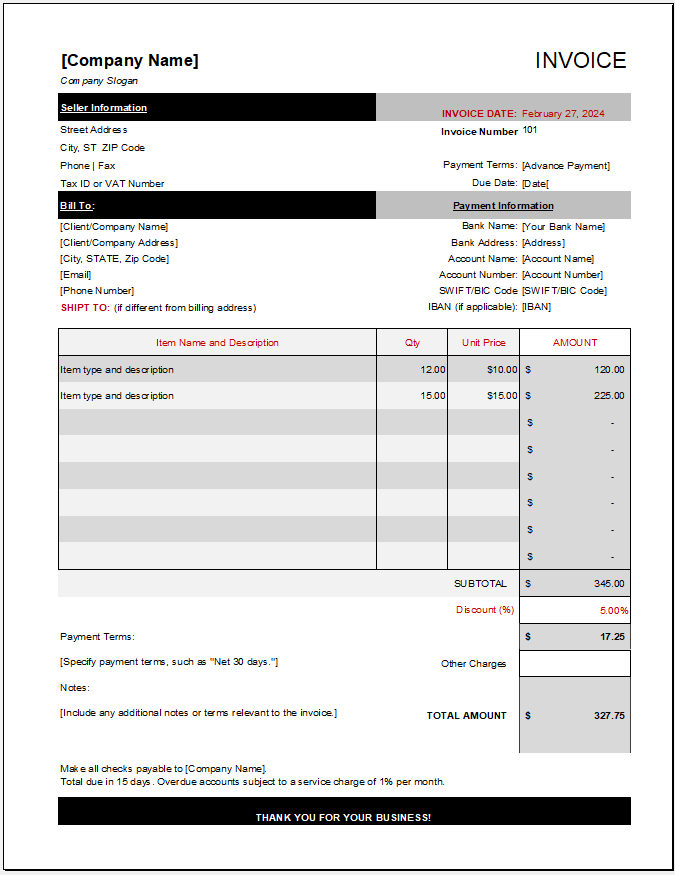Almost every organization uses an invoice to provide billing information to customers and clients. All those people who are selling products and services always need to use an invoice. The invoice has nothing to do with the payment method being used by a service provider. In plain and simple words, the invoice is a critical part of the organization.
What is a standard invoice?
You will always get an invoice if you go to different stores and buy different products from there. It is an indication from the seller or a service provider that you should pay them. The invoice includes the details of all the items and services that have been purchased.
The quantity and price of every individual item is also mentioned in the invoice. This gives a very clear picture to a person of how much he has spent. When he is satisfied with the invoice, he decides to pay.
Invoices used by different stores and service providers may differ from each other, but the purpose of using them and some of the main details are the same. This is the reason, anyone who has never worked with invoices before can easily find a standard invoice and go with it.

Standard Invoice File Size: 34 KB
How does a standard invoice work?
Whenever a person buys products or services from another person or company, he or she receives a document that is a form of request for payment from the service provider. In common language, it is known as ‘bill’.
It is important to know that you cannot use the product or close the service-providing contract with the service provider unless you pay the bill mentioned in the invoice. The bill is always prepared with the mutual consent of both parties and it rarely happens that someone tries to change it.
What are the benefits of using the standard invoice?
There are plenty of utilities for using a standard invoice. A few of them are being discussed below:
It helps to settle disputes:
A bill is not just a request for payment but an important document that also becomes proof of payment for a business relationship between two parties. People who settle disputes with a service provider are asked to show the bill to prove they had a business relationship.
The dispute that can be settled with the help of a bill is usually related to the terms and conditions of the agreement or the payment. All these disputes are handled efficiently with the help of a bill.
It makes the process of buying and selling seamless:
In today’s world, we cannot even imagine buying or selling a product without an invoice because of the ease and efficiency it has brought to our lives. The selling and buying processes become seamless because the payment process is clear to both parties as they know how standard invoices work. So there are never any clashes.
It helps outline information effectively:
Usually, they provide a lot of information on the invoice depending on their preferences. Some details are essential and cannot be missed. However, sellers like to add more details to make this document look more professional.
What information is provided in the standard invoice?
The basic details one can expect to see in the invoice are:
Details of the business:
An invoice is a representation of a business and, therefore, mentions the name and logo of a business in the header section of the document.
List of products or services:
A tabular list of all the services and products purchased by the seller is mentioned in the invoice. In front of each product, the name of the product along with its quantity, and price is mentioned.
Total amount to be paid:
In the footer section of the invoice, the total amount that needs to be paid is mentioned along with all the inclusive and exclusive taxes. This is the part where most of the customers and clients focus. These days, digital tools are used to compute the total amount of Bills to be paid by customers.
Terms and conditions:
Every business has terms and conditions when it comes to issuing a bill and providing services to its customers. Buyers need to know about those terms which are generally printed on the back of the invoice.
- Event Budget Sheet
- Shift-Based Attendance Tracker
- Customer Persona Worksheet
- Entertainment Expense Report
- Vendor Expense Report Template
- Market Analysis Worksheet Template
- Customer Sales Tracker Template
- Business Description Worksheet
- Patient Information Cover Sheet Templates
- Goal-oriented to-do List Template
- Individual Expense Report Template
- Travel Expense Report Template
- Corporate Credit Card Expense Report Template
- Bucket List Template
- Mixed Invoice Template